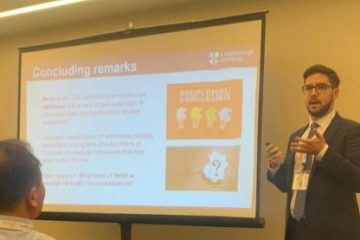Perhaps the biggest transportation research conference in the world – TRB – took place this year from the 11th to 16th of January 2020. LEVITATE could not be missing from this prestigious event, and this year, the project was represented by several members: Dr Alkis Papadoulis, Prof Pete Thomas and Prof Mohammed Quddus from Loughborough University, Dr Jordi Casas from Aimsun and Prof Eleni Vlahogianni from National Technical University of Athens. As expected, Connected and Automated Transport Systems were one of the themes that dominated the agenda of the conference as they have been the research focus of industry and academia for the last few years.
TRB is always an excellent opportunity for European and International projects to interact with each other and attempt to learn from each other’s research. The members of LEVITATE, attended lectern sessions where several CATS-related projects were presented (Co-Exist, HumanDrive among others), and the following conclusions were drawn.
- Connected and Automated Driving data are starting to emerge. Microsimulation software companies are starting to develop their “autonomous” vehicle algorithms based on this data and several studies are starting to employ these models in order to evaluate the impact of Connected and Automated Vehicles in simple road network layouts. These studies could potentially be very useful for Levitate, as they can provide a basis of comparison for the results of Levitate and they can provide useful guidelines regarding the configuration of driving models in order to simulate connectivity and automation.
- The definition of Connected and Automated Vehicles in simulation terms hasCa not advanced significantly during the last few years. This is where Levitate will aim to contribute by defining new CAV behaviours that will emerge due to the sub-use cases so cities can evaluate them in the Policy support tool.
- The transferability of results is still an on-going and sensitive topic for simulation-related projects as simulation models are location specific and models must be individually tailored for each different city of interest.
Additionally, LEVITATE’s most recent piece of simulation work on parking pricing policies in the Connected and Automated Vehicle era was presented in the Freeway and CAV Simulation subcommittee. The session was well attended from experts of the field and the members of the project received very useful feedback that will help strengthen the sub-use case work in the future.
The project is looking forward to attending more meetings in Europe and worldwide in order to exchange opinions and thoughts about its methods and assumptions.


